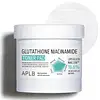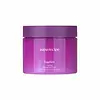What's inside
What's inside
 Key Ingredients
Key Ingredients

 Benefits
Benefits

 Concerns
Concerns

No concerns
 Ingredients Side-by-side
Ingredients Side-by-side

Water
Skin ConditioningCentella Asiatica Leaf Water
Skin ConditioningButylene Glycol
HumectantGlycerin
HumectantDipropylene Glycol
HumectantNiacinamide
SmoothingHydroxyethyl Urea
HumectantSodium Hyaluronate
HumectantAllantoin
Skin ConditioningPanthenol
Skin ConditioningGlutathione
Nelumbo Nucifera Extract
Skin ConditioningArtemisia Annua Extract
MaskingOryza Sativa Extract
AbsorbentSaccharomyces Ferment
Skin ConditioningSolanum Melongena Fruit Extract
Skin ConditioningMelaleuca Alternifolia Leaf Extract
PerfumingHydrolyzed Collagen
EmollientBeta-Glucan
Skin ConditioningHippophae Rhamnoides Fruit Extract
Skin ConditioningAdenosine
Skin ConditioningMadecassic Acid
Skin ConditioningAsiaticoside
AntioxidantAsiatic Acid
Skin ConditioningSqualane
EmollientCaprylic/Capric Triglyceride
MaskingHydrogenated Lecithin
EmulsifyingGlyceryl Stearate
EmollientCholesterol
EmollientXanthan Gum
EmulsifyingPropanediol
SolventHydroxyacetophenone
Antioxidant1,2-Hexanediol
Skin ConditioningEthylhexylglycerin
Skin ConditioningDipotassium Glycyrrhizate
HumectantCitric Acid
BufferingSodium Citrate
BufferingWater, Centella Asiatica Leaf Water, Butylene Glycol, Glycerin, Dipropylene Glycol, Niacinamide, Hydroxyethyl Urea, Sodium Hyaluronate, Allantoin, Panthenol, Glutathione, Nelumbo Nucifera Extract, Artemisia Annua Extract, Oryza Sativa Extract, Saccharomyces Ferment, Solanum Melongena Fruit Extract, Melaleuca Alternifolia Leaf Extract, Hydrolyzed Collagen, Beta-Glucan, Hippophae Rhamnoides Fruit Extract, Adenosine, Madecassic Acid, Asiaticoside, Asiatic Acid, Squalane, Caprylic/Capric Triglyceride, Hydrogenated Lecithin, Glyceryl Stearate, Cholesterol, Xanthan Gum, Propanediol, Hydroxyacetophenone, 1,2-Hexanediol, Ethylhexylglycerin, Dipotassium Glycyrrhizate, Citric Acid, Sodium Citrate
Water
Skin ConditioningMethylpropanediol
SolventDipropylene Glycol
HumectantButylene Glycol
HumectantAllantoin
Skin ConditioningBetaine
HumectantGlycereth-26
HumectantSolanum Melongena Fruit Extract
Skin ConditioningCitric Acid
BufferingBetaine Salicylate
AntimicrobialGluconolactone
Skin ConditioningGlycyrrhiza Glabra Root Extract
BleachingCamellia Sinensis Leaf Extract
AntimicrobialCoptis Japonica Root Extract
Skin ConditioningSchisandra Chinensis Fruit Extract
Skin ConditioningZingiber Officinale Root Extract
MaskingGlycerin
HumectantEthylhexylglycerin
Skin ConditioningDisodium EDTA
Centella Asiatica Extract
CleansingCaprylyl Glycol
EmollientSodium Hyaluronate
HumectantBetula Alba Juice
AstringentMaltodextrin
AbsorbentMelaleuca Alternifolia Leaf Extract
PerfumingHydrolyzed Gardenia Florida Extract
AntioxidantScutellaria Baicalensis Root Extract
AstringentPolygonum Cuspidatum Root Extract
AntioxidantCalendula Officinalis Extract
Skin ConditioningChamomilla Recutita Flower Extract
MaskingRosmarinus Officinalis Leaf Extract
AntimicrobialWater, Methylpropanediol, Dipropylene Glycol, Butylene Glycol, Allantoin, Betaine, Glycereth-26, Solanum Melongena Fruit Extract, Citric Acid, Betaine Salicylate, Gluconolactone, Glycyrrhiza Glabra Root Extract, Camellia Sinensis Leaf Extract, Coptis Japonica Root Extract, Schisandra Chinensis Fruit Extract, Zingiber Officinale Root Extract, Glycerin, Ethylhexylglycerin, Disodium EDTA, Centella Asiatica Extract, Caprylyl Glycol, Sodium Hyaluronate, Betula Alba Juice, Maltodextrin, Melaleuca Alternifolia Leaf Extract, Hydrolyzed Gardenia Florida Extract, Scutellaria Baicalensis Root Extract, Polygonum Cuspidatum Root Extract, Calendula Officinalis Extract, Chamomilla Recutita Flower Extract, Rosmarinus Officinalis Leaf Extract
 Reviews
Reviews

Ingredients Explained
These ingredients are found in both products.
Ingredients higher up in an ingredient list are typically present in a larger amount.
Allantoin is a soothing ingredient known for its protective and moisturizingg properties. Because of this, it is often added to products with strong active ingredients.
Studies show higher concentrations of this ingredient can promote wound healing.
Though it can be derived from the comfrey plant, allantoin is produced synthetically for cosmetic products to ensure purity.
Learn more about AllantoinButylene Glycol (or BG) is used within cosmetic products for a few different reasons:
Overall, Butylene Glycol is a safe and well-rounded ingredient that works well with other ingredients.
Though this ingredient works well with most skin types, some people with sensitive skin may experience a reaction such as allergic rashes, closed comedones, or itchiness.
Learn more about Butylene GlycolCitric Acid is an alpha hydroxy acid (AHA) naturally found in citrus fruits like oranges, lemons, and limes.
Like other AHAs, citric acid can exfoliate skin by breaking down the bonds that hold dead skin cells together. This helps reveal smoother and brighter skin underneath.
However, this exfoliating effect only happens at high concentrations (20%) which can be hard to find in cosmetic products.
Due to this, citric acid is usually included in small amounts as a pH adjuster. This helps keep products slightly more acidic and compatible with skin's natural pH.
In skincare formulas, citric acid can:
While it can provide some skin benefits, research shows lactic acid and glycolic acid are generally more effective and less irritating exfoliants.
Most citric acid used in skincare today is made by fermenting sugars (usually from molasses). This synthetic version is identical to the natural citrus form but easier to stabilize and use in formulations.
Read more about some other popular AHA's here:
Learn more about Citric AcidDipropylene Glycol is a synthetically created humectant, stabilizer, and solvent.
This ingredient helps:
Dipropylene glycol is technically an alcohol, but it belongs to the glycol family (often considered part of the ‘good’ alcohols). This means it is hydrating and gentle on skin unlike drying solvent alcohols like denatured alcohol.
As a masking agent, Dipropylene Glycol can be used to cover the smell of other ingredients. However, it does not have a scent.
Studies show Dipropylene Glycol is considered safe to use in skincare.
Learn more about Dipropylene GlycolEthylhexylglycerin (we can't pronounce this either) is commonly used as a preservative and skin softener. It is derived from glyceryl.
You might see Ethylhexylglycerin often paired with other preservatives such as phenoxyethanol. Ethylhexylglycerin has been found to increase the effectiveness of these other preservatives.
Glycerin is already naturally found in your skin. It helps moisturize and protect your skin.
A study from 2016 found glycerin to be more effective as a humectant than AHAs and hyaluronic acid.
As a humectant, it helps the skin stay hydrated by pulling moisture to your skin. The low molecular weight of glycerin allows it to pull moisture into the deeper layers of your skin.
Hydrated skin improves your skin barrier; Your skin barrier helps protect against irritants and bacteria.
Glycerin has also been found to have antimicrobial and antiviral properties. Due to these properties, glycerin is often used in wound and burn treatments.
In cosmetics, glycerin is usually derived from plants such as soybean or palm. However, it can also be sourced from animals, such as tallow or animal fat.
This ingredient is organic, colorless, odorless, and non-toxic.
Glycerin is the name for this ingredient in American English. British English uses Glycerol/Glycerine.
Learn more about GlycerinMelaleuca Alternifolia Leaf Extract comes from the Tea Tree, Melaleuca alternifolia, Myrtaceae. This tea tree is native to Australia.
Tea Leaf extract contains antimicrobial and anti-acne properties.
This ingredient has perfuming properties and contains linalool and limonene. These fragrance and terpinen components can cause skin sensitivity.
Learn more about the benefits of Tea Tree Oil here.
Learn more about Melaleuca Alternifolia Leaf ExtractSodium Hyaluronate is hyaluronic acid's salt form. It is commonly derived from the sodium salt of hyaluronic acid.
Like hyaluronic acid, it is great at holding water and acts as a humectant. This makes it a great skin hydrating ingredient.
Sodium Hyaluronate is naturally occurring in our bodies and is mostly found in eye fluid and joints.
These are some other common types of Hyaluronic Acid:
Learn more about Sodium HyaluronateWe don't have a description for Solanum Melongena Fruit Extract yet.
Water. It's the most common cosmetic ingredient of all. You'll usually see it at the top of ingredient lists, meaning that it makes up the largest part of the product.
So why is it so popular? Water most often acts as a solvent - this means that it helps dissolve other ingredients into the formulation.
You'll also recognize water as that liquid we all need to stay alive. If you see this, drink a glass of water. Stay hydrated!
Learn more about Water